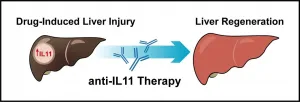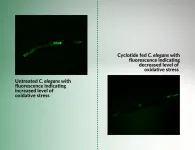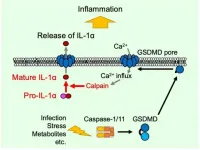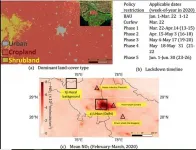Start-stop system of hunting immune cells
Max Planck researchers reveal how immune cells coordinate their swarming behavior to eliminate pathogens effectively together
2021-06-18
(Press-News.org) The body is well protected against invading pathogens by barriers such as the skin. But if you injure yourself and break your skin, pathogens can easily enter your body through the wound and cause severe infections. If this occurs, the innate immune system takes over the first rapid defense with an effective arsenal of cellular weapons infiltrating the wounded tissue in large numbers. As one of the first cell types on the spot, neutrophil granulocytes are recruited within few hours from the bloodstream to the infection site to eliminate potential microbial invaders.
Swarming against infections
"Neutrophils are very efficient in hunting and killing bacteria," says Tim Lämmermann. The group leader at the MPI of Immunobiology and Epigenetics in Freiburg studies this important cell type. Neutrophils are highly abundant cells that make up about 50-70% of white blood cells in the human body. It is estimated that 100 billion neutrophils are produced from stem cells in the bone marrow in an adult every day. "These cells patrol almost all corners of our body, and they are very efficient in sensing anything potentially harmful in our body. Once individual neutrophils detect damaged cells or invading microbes in the tissue, they start secreting attractive signals that act through cell-surface receptors on neighboring neutrophils to recruit more and more cells." By using this intercellular communication, neutrophils can act together as a cell collective and coordinate effectively their clearance for pathogens as a swarm.
A fine line between host protection and tissue destruction
However, this form of beneficial inflammation can also overshoot and lead to massive tissue damage. If the intensity or the duration of the response becomes dysregulated, the same mechanisms that serve to eliminate invading pathogens can also cause collateral damage to healthy tissues. For example, the substances that neutrophils release to kill invading pathogens also erode the meshwork of proteins and sugars, which provides structural support to tissues. "In this study, we started with the question what stops the swarming response to avoid uncontrolled neutrophil accumulation and prevent excessive inflammation, which can contribute to degenerative diseases such as cancer, diabetes, and autoimmune diseases," says Tim Lämmermann. In former studies, he and his team already discovered the molecular mechanisms initiating the collective-like swarming behavior. However, the processes that bring this response to an end have remained unknown.
Neutrophil swarming is still a relatively novel topic in the inflammation and infection research fields, and the underlying mechanisms are just beginning to be investigated. The newest study by the lab of Tim Lämmermann now reveals how neutrophils self-limit their swarming activity in bacteria-infected tissues and thus balance search versus destroy phases for efficient pathogen elimination.
By using specialized microscopy for the real-time visualization of immune cell dynamics in living mouse tissues, the researchers demonstrate that swarming neutrophils become insensitive to their own secreted signals that initiated the swarm in the first place. "We identified a molecular break in neutrophils that stops their movement, once they sense high concentrations of accumulating swarm attractants in large neutrophil clusters" says Tim Lämmermann. "This was surprising as the prevailing view suggested that external signals released from the tissue environment are critical for stopping neutrophil activity in the resolution phase of an inflammation," comments Wolfgang Kastenmüller, collaborating scientist of the Max Planck Research Group Systems Immunology at the University of Würzburg.
An internal start-stop system for optimal bacterial clearance
In light of the discovered start-stop system in neutrophils, the researchers re-evaluated current views on how neutrophils navigate in tissues to eliminate bacteria efficiently. In experiments with neutrophils lacking the stop mechanism, the team observed immune cells excessively swarming and scanning large areas of bacteria-infected tissue, which contrasted the behavior of cells with functioning start-stop system. However, this amplified swarming and scanning did not make these cells better pathogen-killers. "Strikingly, we made the opposite finding. It is not beneficial when neutrophils move around too fast and run around like crazy. Instead, it appears more advantageous for them to stop and enjoy together a nice meal of bacteria - this is more efficient to contain bacterial growth in tissues," explains Tim Lämmermann.
With these results, the team paves the way for a better understanding of neutrophil biology, which is essential for immune host defense against bacteria and could inform therapeutic approaches in the future. Moreover, the swarming behavior and underlying mechanisms could also inform other categories of collective behavior and self-organization in cells and insects.
INFORMATION:
ELSE PRESS RELEASES FROM THIS DATE:
2021-06-18
Singapore, 18 Jun 2021 - Scientists at Duke-NUS Medical School and National Heart Centre Singapore (NHCS), in collaboration with colleagues in Singapore and the UK, have shown that the human form of the signalling protein interleukin 11 (IL-11) has a damaging effect on human liver cells--overturning a prior hypothesis that it could help livers damaged by paracetamol poisoning. The finding, published last week in Science Translational Medicine, suggests that blocking IL-11 signalling could have a restorative effect.
Paracetamol, also called acetaminophen, is a widely available over-the-counter painkiller, and an overdose can lead to serious liver damage and even death. It is the most common pharmaceutical ...
2021-06-18
Most of us have heard of Alzheimer's disease, a neurodegenerative disorder marked by brain cell death and the shrinking of the brain. It is the most common cause of dementia and cognitive impairment, which typically have a devastating effect on a person's quality of life. There is still no cure for Alzheimer's.
One way of tackling the progression of Alzheimer's disease (AD) is to prevent the underlying adverse changes in the brain. A team of researchers from the National Centre for Biological Sciences (NCBS) has recently published a study in the Journal of Medicinal Chemistry, dedicated to neuroprotection against these toxic changes. They used tiny free-living soil worms --called Caenorhabditis elegans--and the often-ornamental ...
2021-06-18
Kanazawa, Japan - Interluekin-1α (IL-1α) is an important part of the immune response, but until now it has been unclear how this molecule is processed from its precursor, pro-IL-1α, and exits the cell during inflammasome activation. Now, researchers from Japan have found that gasdermin D, a protein that was already known to mediate pyroptosis, a form of regulated cell death, plays a crucial role in the maturation and release of IL-1α.
In a study published in March in Cell Reports, researchers from Kanazawa University report that, when the ...
2021-06-18
COVID-19 has changed the world in unimaginable ways. Some have even been positive, with new vaccines developed in record time. Even the extraordinary lockdowns, which have had severe effects on movement and commerce, have had beneficial effects on the environment and therefore, ironically, on health. Studies from all around the world, including China, Europe and India, have found major drops in the level of air pollution. However, to fully understand the impact of anthropogenic causes, it is important to separate them from natural events in the atmosphere like wind flow.
To demonstrate this point, a new study by researchers at the Research Institute for Humanity and Nature, Japan, uses satellite data and mathematical modeling to explain just ...
2021-06-18
Identifying the causes of human neurodegenerative diseases is a global research priority, warranting frequent reviews of the accumulating knowledge. In doing just that, biologists from the Plant Physiology Laboratory at the University of Guam and neuroscientists from the Experimental Medicine Program at The University of British Columbia have published an update on the reputed environmental toxins that have been suspected of being involved in mammal neurodegeneration. Their summary was published in April in the book Spectrums of Amyotrophic Lateral Sclerosis, which is available online ...
2021-06-18
According to a recent Finnish study, higher levels of moderate and vigorous physical activity can curb arterial stiffening already in childhood. However, sedentary time or aerobic fitness were not linked to arterial health. The results, based on the ongoing Physical Activity and Nutrition in Children (PANIC) Study conducted at the University of Eastern Finland, were published in the Journal of Sports Sciences. The study was made in collaboration among researchers from the University of Jyväskylä, University of Eastern Finland, the Norwegian School of Sport sciences, and the University of Cambridge.
Arterial stiffening predisposes to heart diseases, ...
2021-06-18
Tokyo, Japan - In Japan, thousands of homes and businesses and hundreds of lives have been lost to typhoons. But now, researchers have revealed that a new flood forecasting system could provide earlier flood warnings, giving people more time to prepare or evacuate, and potentially saving lives.
In a study published this month in Scientific Reports, researchers from The University of Tokyo Institute of Industrial Science have shown that a recently developed flood forecasting system provides much earlier advance warnings of extreme flooding events than current systems. ...
2021-06-18
Germany is a hotspot for dragonflies and damselflies (Odonata) species in Europe, owing to the range of habitats and climates that it provides. While many recent and mostly small-scale studies suggest long-term declines of insect populations in different parts of Europe, studies of freshwater insects - including dragonflies and damselflies - suggest that some species have increased in occurrence. Researchers of iDiv, FSU and UFZ have now provided a nationwide analysis of the occurrence and distribution of dragonflies and damselflies in Germany between 1980 and 2016. For this, they analysed over 1 million occurrence records on 77 species from different regional ...
2021-06-18
The population on Earth is increasingly growing and people are expected to live longer in the future. Thus, better and more reliable therapies to treat human diseases such as Alzheimer's and cardiovascular diseases are crucial. To cope with the challenge of ensuring healthy ageing, a group of international scientists investigated the potential of biosynthesising several polyamines and polyamines analogues with already known functionalities in treating and preventing age-related diseases.
One of the most interesting molecules to study was spermidine, which is a natural product already present in people's blood and an inducer of autophagy that is an essential cellular process for clearing damaged proteins, e.g., misfolded proteins ...
2021-06-18
URBANA, Ill. - For the most accurate accounting of a product's environmental impact, scientists look at the product's entire life cycle, from cradle to grave. It's a grand calculation known as a life cycle assessment (LCA), and greenhouse gas emissions are a key component.
For corn ethanol, most greenhouse gas emissions can be mapped to the fuel's production, transportation, and combustion, but a large portion of the greenhouse gas calculation can be traced right back to the farm. Because of privacy concerns, however, scientists can't access individual farm management decisions such as fertilizer type and rate.
Nitrogen fertilizer data are an important piece of the calculation because a portion ...
LAST 30 PRESS RELEASES:
[Press-News.org] Start-stop system of hunting immune cells
Max Planck researchers reveal how immune cells coordinate their swarming behavior to eliminate pathogens effectively together









